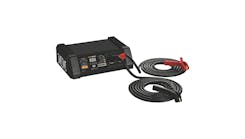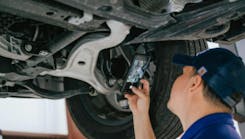Editor's note: This article has been updated from its original 2014 version.
Even in this difficult economy, steering concerns usually are repaired without too many complaints from even the most frugal of customers. Indeed, folks who claim to be selling their vehicles shortly seem to understand that not only do problems in steering systems affect vehicle safety, they also can make vehicles really difficult and tiring to drive, which affects any resale value.
Strangely though, customers who won’t bat an eye at paying for expensive parts still seem to hate paying anything for any diagnostic time. And while there’s no excuse or substitute for proper diagnosis (especially on safety-critical systems) knowing the most common causes of the most common steering problems can reduce your diagnostic time, save you headaches and save your customers money.
Ideally, steering systems should at least be checked quickly whenever a vehicle comes in for service, even if no steering concerns were mentioned, by at a minimum checking for excess play at the wheels and components (in other words, shake a wheel before you remove it) and looking for leaks from the hoses and connections. If there’s time for a road test, checking for pull, wandering and vibrations at various speeds can identify any problems with the steering system that need to be investigated further.
From experience, most vehicles will at some point develop problems in their systems, and fortunately most steering concerns are straightforward and simple to diagnose and repair. Even though some problems are specific to certain vehicles, the top 10 steering problems and fixes do seem to apply to all vehicles (with the few exceptions, noted below).
Here are the most common steering problems – and their fixes – to help speed up diagnosis and keep everyone safe and happy.
Vibration/shimmy/shake when driving
Even though vibrations felt in the steering wheel are probably the most common steering system complaints, the problem doesn’t always come from steering system components, so it’s important to figure out (quickly) from where the offending vibration originates. A common example of this is a “steering” vibration that only happens while braking. It’s wise to look elsewhere for the problem, likely in the front brake rotors.However, if the vibration occurs only at low speed then disappears, then occurs again at highway speeds and disappears when the vehicle speeds up, suspect out of balance wheel assemblies, damaged rims, damaged tires or worn steering or suspension components. These might be visible on inspection or you might need to balance the wheels to verify your suspicion.
One customer recently took his truck into the bush but forgot to put it in 4x4, so he unsurprisingly slid into a tree stump and got stuck in the mud. He got unstuck (“dragged out”) and on the drive home noticed a new steering vibration and he brought the truck in to the shop complaining about this steering vibration.
He was honest about what had happened and lying wouldn’t have fooled anyone – it was obvious what was causing the problem.
We washed off the mud from the inner rims (a common cause of vibrations, as is snow packed into rims after getting stuck in a snowbank), then checked the truck’s steering components (this was one of the GM trucks with an idler arm that has large yet acceptable amounts of freeplay), performed an alignment and soon learned that there was indeed a damaged rim on the vehicle causing the problem. Trees are tough. This customer chose to buy a new set of rims and tires for the truck and drove away happy. But I understand he sold the old set of rims and tires on the Internet – possibly even to one of your customers!
Because so many systems are involved transmitting that vibration, it’s important to quickly determine which system is at fault, which isn’t hard at all when you’ve got an idea of what to look for.
Constantly stiff electric steering
This is one of the few steering problems that doesn’t begin diagnosis by checking fluid levels and curb height.Problems with electric steering systems usually indicate a failure somewhere in the electric power steering system, and it takes a scan tool and service information to diagnose and repair the vehicle properly.
If you don’t have the scan tool available, you can start the diagnosis by checking fuses, checking for binding or damage, checking that wiring is intact and correctly installed and checking that the battery voltage is OK. But realistically you need to check for codes and data in the modules to diagnose and repair the problems properly.
Along those lines, wiggling or disconnecting then reconnecting electric power steering components isn’t a good idea, because the terminals inside the connectors lose their gripping ability after being unplugged even just a few times. This actually can cause intermittent problems to develop and the terminals in the connector to spread.
If you’re in a pinch, shutting the vehicle off and then on again might temporarily repair the problem, but unfortunately it’s not going to fix it permanently. You’re just buying time until the system’s next failure.
However, if you do have the scan tool performing the preliminary diagnostic steps (like checking system voltage and fuses) then hooking up the scan tool and reading codes, and then following the diagnostic and repair information is really straightforward. Electric power steering components typically aren’t repairable – they’re replaced one expensive chunk at a time.
Electric steering — stiff steering on one side only
This problem sounds intimidating but it really isn’t. If electric steering is stiff only in one direction the usual cause is that the steering system is out of calibration and the usually fix is recalibrating it with the scan tool. Yes, this one really is that simple.Constantly stiff hydraulic steering (low assist)
Loss of power assist or low assist most often is caused by low power steering fluid level, lack of power steering fluid pressure or actual binding steering or suspension components themselves. It’s simple to check which problem is present. Because it’s easiest start by checking the fluid, take a look at the steering fluid level and condition to find out if something has gone wrong in the system. If the low assist problem is from a low power steering fluid level, it’s important to figure out where the fluid went which isn’t too hard to do – just look for the leak. Actually, if the complaint is that the vehicle suddenly lost power assist, suspect a major leak somewhere that should be easy enough to spot.If the fluid is okay, check for binding components by raising the wheels off the ground and moving the wheels from stop to stop slowly to verify that they can move freely. Moving the wheels too quickly can cause the fluid to shoot out through the pump and make a mess when system isn’t running. Sometimes leaks hide inside the dust bellows on the rack and can only be identified by removing the clamp (be sure you have a new one to install in case you’re wrong).
If the wheels can be moved from one end of the steering range to the other smoothly when the wheels are lifted off the ground, then the problem likely is in the steering assist system rather than physically binding components. If it can’t be moved when the wheels are raised off the ground to eliminate the load (and the steering column is unlocked), then the problem is probably from bent, seized or damaged components that will need to be replaced.
If the fluid is OK and the wheels move freely, suspect a lack of steering pressure. Blockages and restricted passages do happen, but a lack of power steering fluid pressure is most often caused by problems with the serpentine belt or the pump itself. I’ve seen power steering pulleys shear off internally so that the pulley and shaft can actually be grabbed and slid forward out of the pump housing. A rebuilt pump and flushing the system thoroughly fixed the problem.
Leaks on the driveway or parking space
Hydraulic leaks usually come from leaking seals, O-rings or crimps, and also from incorrectly topping up the fluid. If the cause of the leak isn’t obvious, cleaning off the area and moving the steering wheel back and forth slowly through its entire range of motion, or road testing the vehicle, should help identify the problem area. Fortunately these problems are usually really easy to spot. One important note, it’s no longer safe to use transmission fluid as a substitute for steering fluid. Using the right fluid for the job is really important to prevent problems.Intermittently stiff hydraulic steering
Most recently this problem seems to be caused by aerated power steering fluid or binding steering components. Quickly checking both will identify which is causing the problem.
While you’re checking the power steering fluid, it’s wise to also see if there’s anything else that seems “off” with it. If it smells funny or it’s a strange color the fluid might be contaminated which points to even larger problems. Also check for tiny particles in it that might be bits of seals or even particles of the pump itself. In such cases replacing and flushing the contaminated fluid after the repair is important to keep the problem from returning and from damaging new parts.
Steering wheel off center
If the vehicle travels straight down the road but the steering wheel is off center, the most common reason is a problem with alignment angles possibly due to bent or damaged suspension or steering components. A typical complaint along these lines is that the vehicle hit a curb and now the steering wheel is off. These problems seem to be more common when the weather gets bad and vehicles slide into things.
The trick is figuring out quickly and accurately what to replace or adjust, since it can be really tough to figure out what’s actually bent or shifted. I try to compare one side of the vehicle to the other to see what looks damaged. I also check the setback of the wheels to see if they’re even. In any case, an alignment is needed to verify the repairs. If I’m not the one doing the alignment and the repair involves removing steering components, I try to install the new parts so as to make the alignment go much easier by counting the number of revolutions it takes to remove threaded components and installing the new components the same number of turns so that it ends up in close to the original position.
Hydraulic steering not returning to center after a turn
A slight binding in steering or suspension components usually causes this problem, and unfortunately it often happens after an impact with something like a curb, or after a drastic change in alignment angles (but most often this happens after an impact).The solution is to inspect for damaged, bent and binding components and correcting the alignment angles accordingly.
Steering that pulls or drifts
Driving a vehicle like this can be really tiring, especially on long highway trips.Most of the time this problem is fixed by performing a four-wheel alignment and correcting alignment angles, but uneven tire pressures and poor tire condition are also likely to cause this very common problem. Tire problems also can make a vehicle pull or drift, and if that’s what you suspect, it’s easy enough to swap tire position on the vehicle (remembering to check for directional tires) to see if the problem changes or disappears. It’s also easy enough to check that the vehicle is the same height from side to side while it’s resting on the ground. If not, suspect suspension problems that affect alignment (or a flat tire).
Squeals
Squealing noise – intermittent or constantly – usually is caused by a problem in the belt or pulleys, and not necessarily the steering pump pulley itself. Diagnose the problem by removing the belt (marking direction of rotation first) and spinning all of the pulleys by hand, checking for problems, binding and free play in all of the pulleys. Also make sure the belt tensioner is providing enough tension too since they do tend to fail. One customer actually increased the height of the alternator by sticking shims under the alternator mounting points to increase tension on the belt to get rid of an annoying squeal from his high performance engine. He used a pry bar and hammer to get the belt on and off the pulley.Also check the belt itself for cracks, glazing, missing chunks or contamination. Noting the way the belt came off and also the direction of rotation can save headaches later on. Taking a photo may be the easiest way to do this.
If contamination is a problem then clean off all the pulleys before replacing the belt so the new belt isn’t wrecked too. Also check that the pulleys are correctly aligned with each other, especially if one of the pulleys has been recently replaced.
Conclusion
Most vehicles will develop a problem in the steering systems at some point so it’s important to know where to begin diagnosis and repair so that vehicles get repaired quickly and accurately. Steering systems are so important to vehicle safety and it’s really noticeable when they fail.With practice and experience you’ll be able to diagnose and repair problems quickly and accurately and keep both you and your customers happy and safe.


